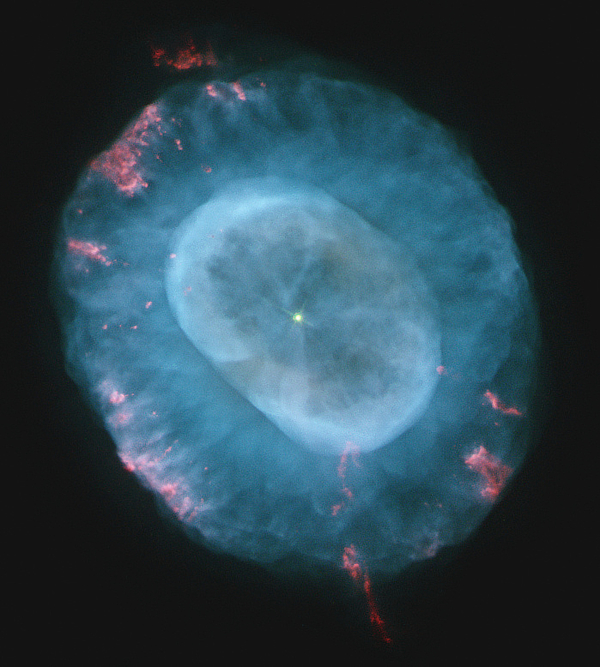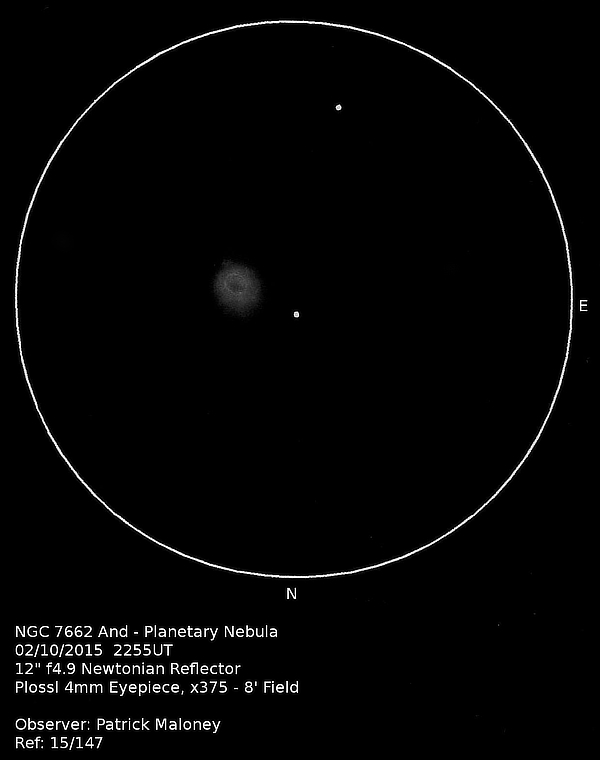NGC 7662 in Andromeda
September 2024 - Nebula and Cluster of the Month
Our object this month is, by contrast to recent objects, very bright and very easy to see. Let’s relax into autumn with a nice easy target.
Discovered, of course, by William Herschel, NGC 7662 in Andromeda is one of the brightest planetary nebulae in the sky, and is particularly well-placed for northern hemisphere observers in September. At declination +42.5°, it should be visible to most southern hemisphere observers, too, barring those below about latitude 30, where the object only rises 18° above the horizon.
It lies at the western end of Andromeda, in a field fairly rich in 5th and 6th magnitude stars. The closest ‘named’ star is 13 Andromedae (magnitude 5.7), 26’ to the planetary’s NNE.
On discovering the object on the night of 18 October 1784, Herschel described it as Bright, round. A planetary. Pretty well-defined disk. 15” diameter.

NGC 7662 has the Vorontsov-Velyaminov classification of III + IV, which indicates that there are two components, an irregular disc (III) and a ring structure (IV).
The magnitude of NGC 7662 is widely quoted at 8.2, and this must be about correct. The object can be glimpsed as a stellar point in 10x50 binoculars. A matter that often puzzles me is the quoted magnitudes of planetary nebula central stars. The Deep Sky Field Guide to Uranometria quotes a magnitude of 12.5 for the central star. The Night Sky Observer’s Guide Volume 1 states that it is 13.17 (var). This seems very precise, especially for a variable star. Some observers claim to have seen the central star visually. The late Steve Coe, in his published observations, says that using a 17.5” reflector at a magnification of x320, ...it appears annular or ring-like, central star suspected in good seeing.
With a smaller instrument (a 13” reflector), however, he sees ...several rings around a central star.
At x330, the central star Comes and goes about 30 percent of the time.
Even with a 6”, he reports that ...the central star is seen some of the time.
Are these differing reports with different telescopes showing the actual variation in the star’s brightness? It seems odd that a 6” telescope would show the star some of the time, a 13” shows it 30% of the time, whilst in a 17.5” telescope, the star is merely suspected in good seeing.
I found another reference to the central star in The Night Sky Observer’s Guide. Here it is stated that in an 8” or 10” telescope, the central star is not visible. In 12” or 14” scopes, the star is very faint
, whereas with 16” or 18” scopes, the central star is very difficult but a twinkle may be glimpsed in periods of good seeing.
I have never seen the central star. On my 2015 observation of NGC 7662, reproduced here, the star shown to the east of the planetary nebula is magnitude 13.5 and was very clearly visible. If the central star is magnitude 12.5 (or even 13.17), then it would also have been very clearly visible.

Wide-field images of NGC 7662 in which the central star is visible show that the 13.5 magnitude star to the east is very much brighter than it.
As a last word on the central star, in a study published in the Astrophysical Journal in 2004, Martín A. Guerrero et al determine that its mass is likely to be 0.605 solar masses.1
I made my first observation of NGC 7662 in 1984 with my 4.5” reflector. I wrote the following in my notebook. At low finding power (x22.5) this object is indistinguishable from a star. x45 reveals a very small disc when compared with stellar points. No detail is visible at this magnification. At high power, x150, the nebula could be seen to be elongated, a faint outer envelope was visible and the object was suspected of being annular. A very bright planetary nebula.
This is a deep-sky object that rewards the user of a small telescope.
The 2015 observation shown here has these notes attached: Very, very bright. Quite elongated. Pale blue in colour. Darker in the middle, making it appear annular. Faint extensions are visible outside the brighter part of the nebula. There is a brighter ring structure within the bright nebula.
Whatever size telescope you have, then, will reveal some detail in this object, making it a prime target no matter your instrument or experience.
| Object | RA | Dec | Type | Magnitude |
|---|---|---|---|---|
| NGC 7662 | 23h 25m 53s | +42° 32’ 08” | Planetary nebula | 8.2 |
References:
- Physical Structure of Planetary Nebulae: II NGC 7662, arXiv:astro-ph/0407029, https://doi.org/10.48550/arXiv.astro-ph/0407029.